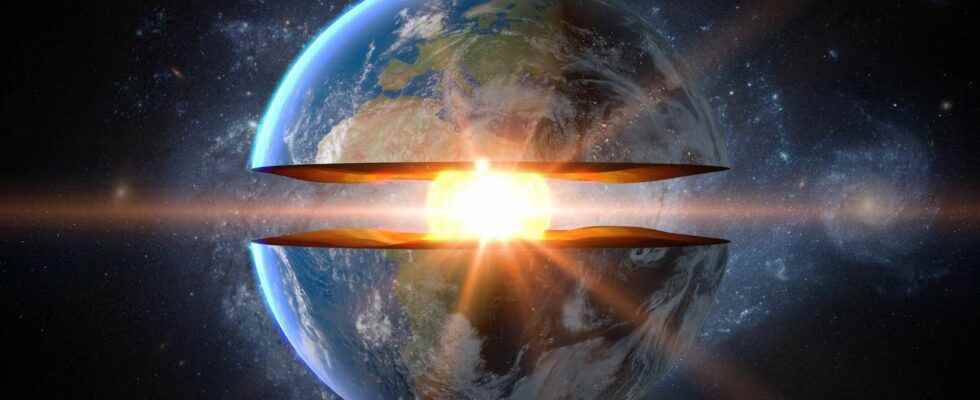How to know the internal structure of the Earth? If the seismic method, by generation of artificial waves, today makes it possible to image in finesse the architecture of the outermost terrestrial envelope, the contribution of distant earthquakes has been decisive in understanding the organization of the deep levels. . The seismic waves generated by the most powerful earthquakes have thus made it possible to characterize the different terrestrial envelopes and to determine their physical characteristics.
It was in 1889, in Potsdam, Germany, that the first recording of an earthquake using a seismograph took place. The movements of the ground recorded on April 17 were generated by a strong earthquake magnitude in Tokyo, nearly 9,000 km away.
The beginnings of seismology
Thanks to the refinement of the measurement tools, the recordings will then follow one another. In 1897, Richard Dixon Oldham characterized for the first time the different types of seismic waves : P, S and surface. A few years later, this geologist British estimates, thanks to the analysis of the times of propagation of the waves generated by many earthquakes, that the interior of the Earth is not uniform. It would have a nucleus, the size of which he estimates at around 5,100 km in diameter. Even if the measurements are imperfect (the kernel solid of the Earth is actually 6,960 km in diameter), these first results mark the beginning of a new discipline, seismology. It is discovered that the Earth’s natural earthquakes can be used to probe its interior. A major leap in the understanding of our Planet.
Characterization of the Moho
In 1909, the recording of an earthquake that struck Zagreb enabled the Croatian, Andrija Mohorovicic, to characterize an essential discontinuity in the upper part of the Earth. The sudden acceleration of the P waves thus made it possible to light the interface between the crust and the coatwhich is characterized by a major difference in mineralogical composition, explaining the change in speed waves. This interface is now commonly called the Moho, in honor of its discoverer. The seismologists thus begin to build, little by little, an increasingly precise image of the internal structure of the Earth.
Distant earthquakes, shadow zone and outer core
The study of large distant earthquakes has in particular made it possible to refine knowledge of deep envelopes. Two phenomena are particularly important: the generation of a seismic shadow zone and the phenomenon of refraction.
For earthquake epicenters located less than 11,500 km away, wave reception is rather banal: P then S waves arrive following a direct path, without being refracted on an interface. On the other hand, seismologists have discovered that, when a station is located between 11,500 and 14,500 km from the epicenter, no P or S wave arrival is recorded! This particular area has been referred to as the “seismic shadow zone”. This phenomenon illustrates the presence of an interface located at a depth of 2,900 km, the Gutenberg discontinuity, which marks the limit between the mantle and the outer core.
From a distance from the epicenter of 11,500 km, the path of a P wave will thus meet the mantle-core interface, which represents a major change in composition. The incident wave will then break up: part of its energy will be reflected in the upper level, another will be transmitted in the lower level, generating a refracted wave whose speed and angle will be different from those of the incident wave. These refracted waves travel through the outer core at a slower speed than the mantle, then cross the Gutenberg discontinuity again to re-enter the mantle. We then speak of PKP waves. Each change of medium will induce a modification of the path of the wave, thus generating a shadow zone, where, for a given earthquake, no single P or S wave arrives. The shadow zone ends with the arrival of the first PKP waves, which have therefore crossed the mantle (P), the outer core (K) and the mantle (P) again before arriving at the station.
Seismologists have also noticed that a station located beyond 14,500 km from the epicenter will not receive simple S waves either: those which are recorded show anomalous propagation speeds, illustrating a complex path inside. of the globe. It appears that S waves, which are shear waves, cannot propagate in the outer core. This observation led to the conclusion that it is liquid. S waves that are received beyond this distance to the epicenter have actually traveled as P waves into the outer core. Upon exiting the nucleus, they can either revert back to S waves or remain as refracted P waves. We will then speak of SKS or SKP waves. These complex waves are notably faster than simple S waves.
Identification of the inner core
This principle of transmission and refraction of waves has also made it possible to identify the presence of the inner core and to characterize it. The shadow zone associated with the presence of the liquid outer core is in fact only relative, since certain complex waves are still recorded there. This is the case for PKiKP waves, which are significantly slower than simple P waves. They made it possible to identify the presence of the solid seed, in other words the inner core. The path of these waves is therefore as follows: mantle (P), liquid outer core (K), reflection on the outer core (i), liquid outer core (K), mantle (P).
Experiments on the speeds of the waves then made it possible to refine the model of terrestrial architecture. It was thus possible to put forward hypotheses on the composition of each envelope: the speed of the waves indicates that the mantle must be rich in silicon while the kernel is a alloy of nickel-iron.
Interested in what you just read?
